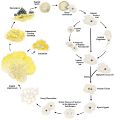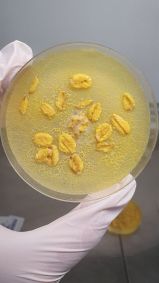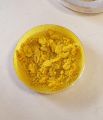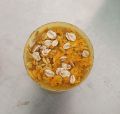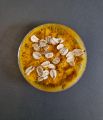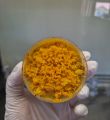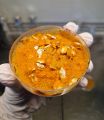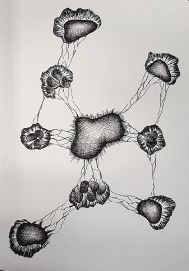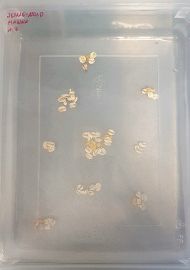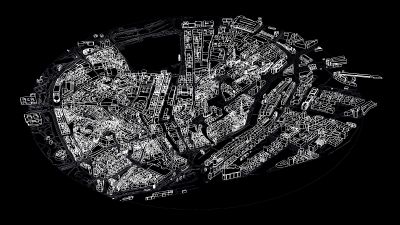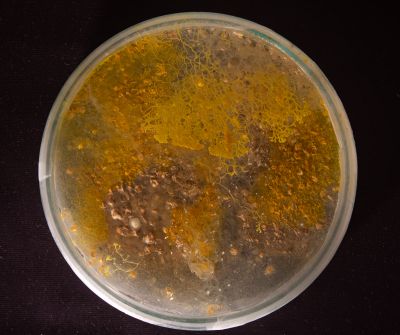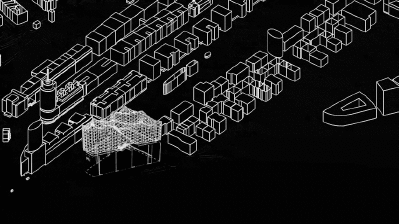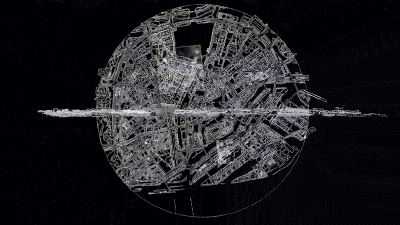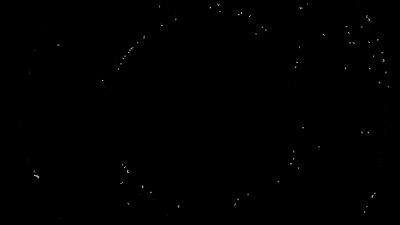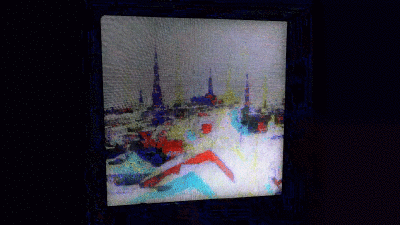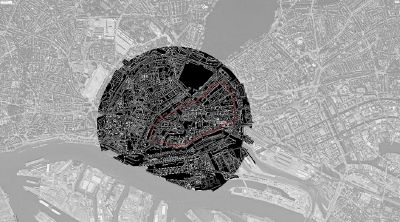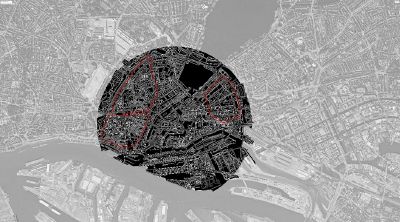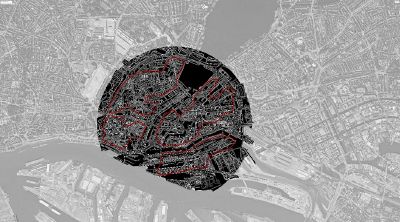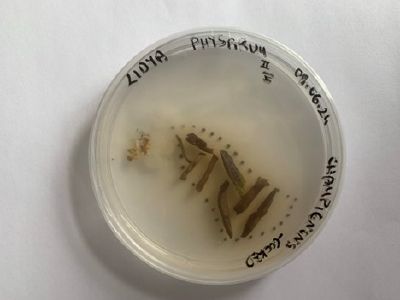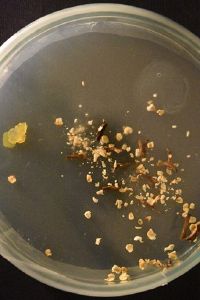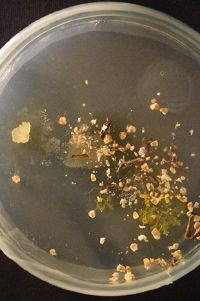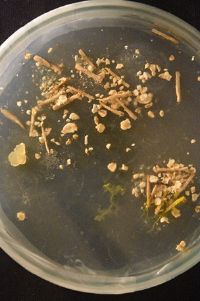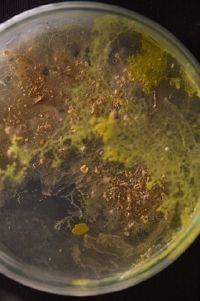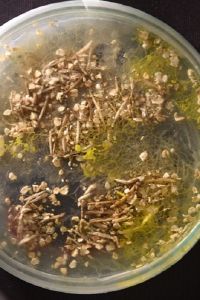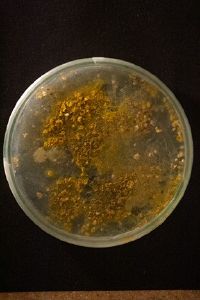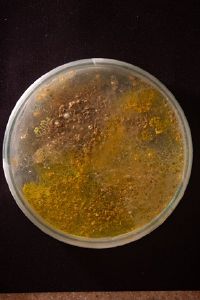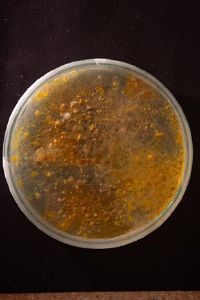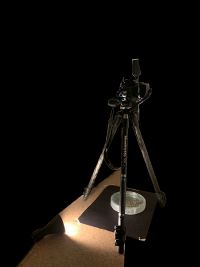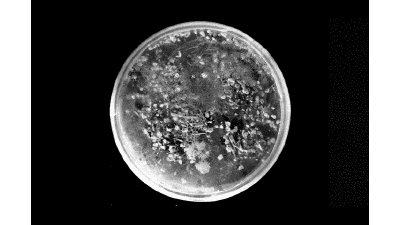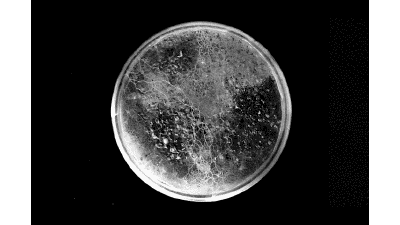No edit summary |
No edit summary |
||
| (One intermediate revision by the same user not shown) | |||
| Line 198: | Line 198: | ||
'''<big>BLOB</big>''' | |||
'''<big>Project ''"BLOB"''</big>''' | |||
The video artwork ''Blob'', produced for the "Beyond the Screens" project module under the guidance of Reinhard König for the City Digital Skin Art Festival (CDSA), is a collaborative effort by Amna Chaudhry, Torben Zsagar, and Dicle Lidya Çolak. | The video artwork ''Blob'', produced for the "Beyond the Screens" project module under the guidance of Reinhard König for the City Digital Skin Art Festival (CDSA), is a collaborative effort by Amna Chaudhry, Torben Zsagar, and Dicle Lidya Çolak. | ||
| Line 204: | Line 205: | ||
The creation of the slime mold installation, specifically the Petri dish setup, was carried out by Dicle Lidya Çolak in the BioLab of the Bauhaus-Universität Weimar. This installation was made possible by the expertise, skills, and equipment gained from the courses "DIY BioLab Driver’s License" and "Growing Microorganisms for Bioart Projects," led by Alessandro Volpato. The project reflects the combined outcomes of the "Growing Microorganisms for Bioart Projects" and "Beyond the Screens" courses. | The creation of the slime mold installation, specifically the Petri dish setup, was carried out by Dicle Lidya Çolak in the BioLab of the Bauhaus-Universität Weimar. This installation was made possible by the expertise, skills, and equipment gained from the courses "DIY BioLab Driver’s License" and "Growing Microorganisms for Bioart Projects," led by Alessandro Volpato. The project reflects the combined outcomes of the "Growing Microorganisms for Bioart Projects" and "Beyond the Screens" courses. | ||
for further details: [[ | for further details: [[GMU:Growing microorganisms for bioart projects SoSe24 / Lidya / Blob]] | ||
Background and Context | Background and Context | ||
Latest revision as of 12:32, 21 September 2024
Species
Physarum Policephalum is an eucaryotic organism which belongs to the class of Myxogastria. It passes a life cycle of morphologic phases, with the phase in which the multinucleate cells form a plasmodium (thin film, with visible branches) often being used for study purposes. This slime mold can be found in cool, humid, darker places, for example on rotten wood in the forest.
Images taken from: https://www.ctvnews.ca/sci-tech/strange-yellow-slime-mold-can-remember-where-it-left-food-study-says-1.5326525
https://knowledge.carolina.com/discipline/life-science/biology/the-slime-mold-physarum-polycephalum/
Growing of Physarum
To be able to use the plasmodium for projects or study purposes, bigger cultures of Physarum have to be grown.
Step 1: Preparing petri dishes:
Materials: Petri dishes, Erlenmeyer flask/pot, distilled water/tap water, powdered agar, scale, spoon, aluminium foil
The easiest gel to make is agar-agar-medium at a ratio of 1 to 100:
| Component | Quantity | Custom Quantity |
|---|---|---|
| water | 100 ml | x |
| agar agar | 1 g | x |
- Fill the needed amount of water either into a pot or the Erlenmeyer flask
- Weigh the needed amount of powdered agar (e.g. by using some aluminium foil as a dish)
- Stir the agar into the water
- Stir and heat the mixture until it's boiling (by using the stovetop or microwave) and take it off the heat before it boils over
- Pour the mixture into the petri dishes until they are max. halfway full, close the lids and let them cool down until the medium has solidified
Step 2: Preparing food for the slime mold
Since Physarum is capable of ingesting material by phagocytosis, it needs "food" to grow, if it's starved, it will escape.
A supply of oat flakes can be used as a source of food.
Newly bought oat flakes can be put into a sealed container (e.g. a glass bottle or a mason jar), but if you want to try to prevent future contamination as much as possible, the oat flakes can be sterilized:
Materials: Glass jars with lids, cotton wadding, aluminium foil, water, pressure cooker
- Prepare a jar with a lid by putting a hole into the lid and insert some cotton wadding tightly into the hole (the hole in the lid is very important, otherwise the jar might burst inside the pressure cooker)
- Fill some oat flakes into the jars, close the lid and put aluminium foil over the lid to prevent contamination later on (cover the lid completely)
- Pour enough water into the pressure cooker, but not so much that the glasses are floating (follow manual for guidance), place the glasses inside
- Close and lock the lid and wait until the needed temperature and pressure point are reached (121°C, 15 PSI)
- Reduce the at minimum heat at which it is possible for the water to keep boiling
- From that point on, wait about 50 minutes and ensure that the pressure of 15 PSI is kept throughout this time
- After that wait for the cooker to cool down on it's own and only then release the pressure to prevent it from boiling over
- Take out the jars, let them cool down and only open them under a flow hood with gloves and disinfected hands
Step 3: Starting a new culture
Materials: gloves, tweezers, bunsen burner, paper towels, 70%-alcohol, petri dish with agar-medium, oat flakes
- (put on the flow hood and disinfect the surface you are working on with alcohol, however the flow hood is not absolutely necessary )
- put on gloves
- spray a paper towel with alcohol and clean the tweezers, then hold them over the flame of the burner (doesn't have to be long) (and put them into the flow hood)
- disinfect your hands with alcohol before working with the slime mold
There are two ways for starting a new culture of Physarum
- Using a part of an already existing culture:
- From the existing culture take an oat flake (or multiple) with slime mold on it with the tweezers and place them in the middle of the new petri dish
- Place oat flakes as food in the petri dish around the flake with the mold
- To prevent future contamination the petri dish can be sealed with Parafilm
- Preserved Physarum comes dried on a filter paper inside a sealed bag
- Place the paper in the middle of the petri dish and put drops of water on the paper to reactivate the slime mold
- Place oat flakes around the paper
- Optionally the petri dish can be sealed with Parafilm
Step 4: Taking care of Physarum
To keep the slime mold from escaping it has to be fed regularly. How often and in what way it has to be fed depends on the purpose of the culture. It is possible to do this under the flow hood in an attempt to keep things sterile, however it is also possible to do it on the usual work space (disinfect first and still keep hands and tweezers clean)
- In the beginning feed Physarum every two days by using the tweezers to drop a couple of oat flakes into the petri dish until the dish is completely covered with Plasmodium
- After the culture has reached this stage, just throw the oat flakes on top of it
- Since the slime mold grows quickly it may need food every day at some point
- It is possible to keep making new cultures from this one by repeating the previous steps
Projects with Physarum Policephalum
Improving Tokyo's rail system (by Atsushi Tero from Hokkaido University, Sapporo, Japan)
While looking for food to continue growing the slime mold detects the food from afar and expands various brands in it's direction. When it has reached the food sources it only keeps the branches with the most efficient way of transporting the nutrients.
Japanese scientists from the Hokkaido University in Sapporo used this characteristic to try and find room for improvement in Tokyo's rail system.
They placed oat flakes in a wet dish resembling the locations of different major cities in the Tokyo area. Since the slime mold prefers dark places, it was possible for Tero to use bright light as mountains and lakes so that the slime mold would avoid these spots while growing towards the oat flakes.
In the end the slime mold created a network which was very similar to the actual rail system.
Source: https://www.nationalgeographic.com/science/article/slime-mould-attacks-simulates-tokyo-rail-network
"Fusion" - Creating Art(ist) with slime mold (Project by Hanna Bremerich, Bauhaus Universität Weimar)
With this project I planned on permanently fusing the artwork and the artist together so that they are completely inseparable. Usually the answer to the question of how much of a connection there is between an artist and their work isn't a trivial one. There is no doubt that because of the intention and the process of creating the artwork there is always "a part" of the artist themselves integrated in the painting but mostly it's not always a physical connection and that is exactly what I wanted to achieve: An artwork that is the artist themselves at the same time.
- To start the project I studied the movement of the slime mold during our course "Growing microorganisms for bioart projects" so that I could create a drawing which the slime mold theoretically could create in a similar way.
- I prepared plastic dishes with an agar-agar-medium in the dimensions of a A4-sheet
- I placed the oat flakes with Physarum on them in the spots of bigger "blobs" and the food on the spots with that represented the individual flakes
- I checked on the slime mold every day and kept placing new oat flakes onto the same spots every day so that the slime mold would hopefully not move away from the spots resembled in the drawing and would create something similar
- After 14 days I ended the project
- The slime mold created multiple versions that were similar to the drawing, however day 11-14 were the closest
//Doku by Hanna Bremerich
Project "BLOB"
The video artwork Blob, produced for the "Beyond the Screens" project module under the guidance of Reinhard König for the City Digital Skin Art Festival (CDSA), is a collaborative effort by Amna Chaudhry, Torben Zsagar, and Dicle Lidya Çolak.
The creation of the slime mold installation, specifically the Petri dish setup, was carried out by Dicle Lidya Çolak in the BioLab of the Bauhaus-Universität Weimar. This installation was made possible by the expertise, skills, and equipment gained from the courses "DIY BioLab Driver’s License" and "Growing Microorganisms for Bioart Projects," led by Alessandro Volpato. The project reflects the combined outcomes of the "Growing Microorganisms for Bioart Projects" and "Beyond the Screens" courses.
for further details: GMU:Growing microorganisms for bioart projects SoSe24 / Lidya / Blob
Background and Context
“The "Beyond the Screens" project module explores the potential of large-scale urban screens and media facades as platforms for visualizing ecological processes, aiming to make climate change tangible, visible, and experiential in public spaces. The project challenges the anthropocentric viewpoint by asking how we can design environments that recognize the needs and dynamics of non-human organisms, extending beyond human understanding and interests. By mapping, tracking, and narrating interactions within urban ecologies, the project seeks to give a voice to beyond-human species, using digital screens and media architecture to bridge the gap between art, science, and technology.”
For our investigation, an environment was prepared for Physarum polycephalum—commonly known as "Blob"—a microscopic organism frequently used in bioart due to its similarities to human social behavior. This experiment allowed Blob to rediscover the city of Hamburg, where the selected screen is located. By viewing the city through the perspective of a non-human actor, we aimed to examine its past and future, moving beyond the human-centered transformations that have shaped Hamburg over time.
Objectives of the Project
The project aims to explore how urban screens can serve as ecological visualization zones, making climate change perceptible and experiential to the public. By engaging a non-human actor like Blob, the project seeks to reimagine urban environments, highlighting the often-overlooked dynamics of non-human organisms. Our goal is to create a narrative that informs and inspires a re-evaluation of humanity's relationship with the natural world, fostering greater public awareness at the crossroads of art, science, and technology.
In order to make the artwork more impactful, we chose to maintain a strong connection to the city context. Our intention was for participants to engage with a work that directly reflects the location they are in, as they view it on the screen. To achieve this, we analyzed the historical development of Hamburg within the region surrounding the Elbphilharmonie building. Blob follows the city’s growth along a historical timeline and, at a certain point, begins to determine how the city will evolve in the future.
Man-Made Cubic Structures / Human vs. Nature / Survival of the Fittest
Organic Folding Evolving Structures / Human with Nature / Coevolution
Project Overview / Storyline
The Blob project is rooted in the exploration of humanity's relationship with nature, particularly focusing on themes of rebirth, consumption, and the cyclical nature of life. By replacing the human actor with Physarum polycephalum (Blob), the project shifts the narrative from a human-centered perspective to one that considers the agency and behavior of a non-human organism. The Elbphilharmonie in Hamburg, a symbol of architectural evolution and adaptation, serves as the starting point for this exploration. Through Blob’s movements and interactions within the city, the project reveals how urban environments can be understood and shaped by non-human actors, challenging conventional design practices and encouraging a rethinking of human impact on nature.
storyline phase1/ birth
storyline phase2/ exploration
storyline phase3/ undefined
storyline phase4/ dead end
Content made by: Torben Zsagar & Dicle Lidya Çolak
Editing made by: Amna Chaudhry
Petri dish installation
Method
To enable the Blob to replicate the historical growth of Hamburg up to the present day, we began by analyzing the city’s population density distribution from its earliest settlement to the present. Understanding how Hamburg had developed over time was crucial for guiding the Blob's growth and enabling it to simulate potential future expansion.
To achieve this, extensive historical research was conducted, focusing on the city’s development. Based on this research, we selected three key maps representing Hamburg in 1300, 1892, and 2018, which provided data on the population density distribution across different eras.
These maps were then used to mark the development of the selected area in Hamburg on a city plan. The diagrams derived from this plan were first scaled to match the control group petri dishes (10 cm diameter) and then adjusted for the petri dish used in the timelapse photography (20 cm diameter). This method allowed us to guide the Blob’s growth in a way that mirrored Hamburg’s historical evolution, ensuring that the experiment was both visually and conceptually aligned with the project’s objectives.
diagram based on 1300’s map
diagram based on 1892’s map
diagram based on 2018’s map
first control group petri dish, based on 1300’s map diagram
Growing the Blob According to Historical Data
Step 1 - Initial Placement: The Blob was initially placed on the site representing the Elbphilharmonie building in the petri dish. To simulate the settlement depicted in the first diagram, dating back to the 1300s, food sources were strategically positioned to help orient and sustain the Blob’s growth.
Step 2 - Two Days of Growth: Over the course of two days, the Blob fully explored the designated settlement area, effectively replicating the development of Hamburg up to the 1300s.
Step 3 - First Food Replacement: To simulate Hamburg’s growth between 1300 and 1892, a second set of food sources was introduced in the laboratory. This placement followed the population density diagram from the 1892 map.
Step 4 - Eight Days of Growth: Within eight days, the Blob expanded to cover the areas corresponding to the population density of Hamburg in 1892.
Step 5 - Second Food Replacement: The final set of food sources was introduced based on the dense urban fabric map from 2018, representing the present-day population distribution of Hamburg.
Step 6 - Sixteen Days of Growth: At this stage, the Blob was no longer guided by external intervention. Instead, it was left to determine the future overpopulation and consumption scenario of the city on its own. The experiment continued until the 16th day, when the Blob began to weaken due to stress, marking the end of the timelapse.
11 days of growth
14 days of growth
16 days of growth
Shooting for 3 weeks of growth
The process of cultivating the Blob required careful attention and time to ensure strong and visible growth. Over three weeks, photos were taken every 15 minutes to document the Blob's growth. The project aimed to align the Blob’s growth with a symbolic timeline reflecting Hamburg’s historical expansion from the 1300s to the present. This approach allowed the Blob’s growth pattern to mimic the city’s development, adding a deeper layer of meaning to the visual narrative. However, the process was not without challenges, as the risk of contamination could lead to mold formation in the Petri dish, potentially compromising the results.
Timelapse
https://www.youtube.com/watch?v=X7vDehMDgdI&list=PLdUPcma_TIKAQtHGJT5HqQPzl3DyyC90i
https://www.youtube.com/watch?v=PJEMDSNxfdg&list=PLdUPcma_TIKAQtHGJT5HqQPzl3DyyC90i&index=3
After capturing the images over the three-week period, Adobe Lightroom was used to compile and organize the photos. This phase was crucial in preparing the raw visual data for further refinement. The next step involved using Adobe Premiere, where contrast and overlap adjustments were made to enhance the visuals and ensure consistency across the sequence. These adjustments were necessary to prepare the images for final processing in TouchDesigner, where the visual narrative of the Blob’s growth would be fully realized.

